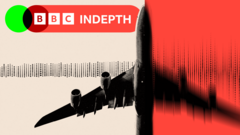Andrew Davies was excited for his journey to New Zealand, where he would manage a Doctor Who exhibition. However, the initial tranquility of his flight from London to Singapore quickly turned chaotic as the plane suddenly encountered severe turbulence. "It felt like a rollercoaster," he recalled, as he was thrust back into his seat, and chaos erupted around him—a scene echoed by many passengers suffering injuries and even a tragic death. While deaths from turbulence remain exceedingly rare, injuries are a grave concern, with over 200 severe injuries reported in the U.S. since 2009.
The underlying cause? Experts point to climate change, altering upper-atmospheric conditions and increasing turbulence intensity. Professor Paul Williams of the University of Reading asserts that severe turbulence could increase by two- to three-fold in coming decades, with passengers already experiencing longer bouts of turbulence on their flights.
The North Atlantic route, frequently trodden by flights between the U.S., UK, and Caribbean, has seen a 55% rise in severe turbulence over the last 40 years, primarily due to climate-induced changes. Among the sky's turbulence creators are convective turbulence from thunderstorms and clear-air turbulence from unpredictable wind shifts, with climate change exacerbating these conditions.
As temperatures rise, storms intensify; thus, more substantial updrafts in storm clouds lead to severe turbulence experiences for passengers. Additionally, disturbances associated with the fast-moving jet stream are projected to worsen, driven by climate fluctuations, with temperatures south of the jet stream rising faster than those to the north.
This uptick in turbulence forecasts raises alarms for fliers. More than 20% of UK adults harbor a fear of flying, and many view increased turbulence as a direct threat. Airline industry experts, however, emphasize that modern aircraft are resilient to turbulence, with wings designed to withstand extreme conditions.
Airlines are consequently taking measures to "turbulence-proof" flights. Advanced technologies like predictive modeling of turbulent regions are enhancing flight safety measures, with some airlines even changing cabin service protocols to mitigate injury risks. Innovations like turbulence-cancelling technology for smaller aircraft are also in the works, promising a smoother flying experience.
Nevertheless, the specter of climate change looms large over future air travel. Eurocontrol indicates that increased turbulence will lead to operational setbacks, raising costs for airlines and amplifying their carbon footprints. Considering the economic and safety implications of turbulence, industry figures stress the importance of continued research and adaptation.
While turbulence might become more common—potentially leading to more time seated with seatbelts fastened—experts maintain that understanding and preparing for these changes can mitigate risks. Andrew Davies has recognized the necessity of vigilance in the cockpit, but he remains resolute in not allowing fear to overshadow his flying experiences. As we brace for the realities of climate change in the skies, the adaptability of aviation technology offers a glimmer of hope amid the turbulence.















